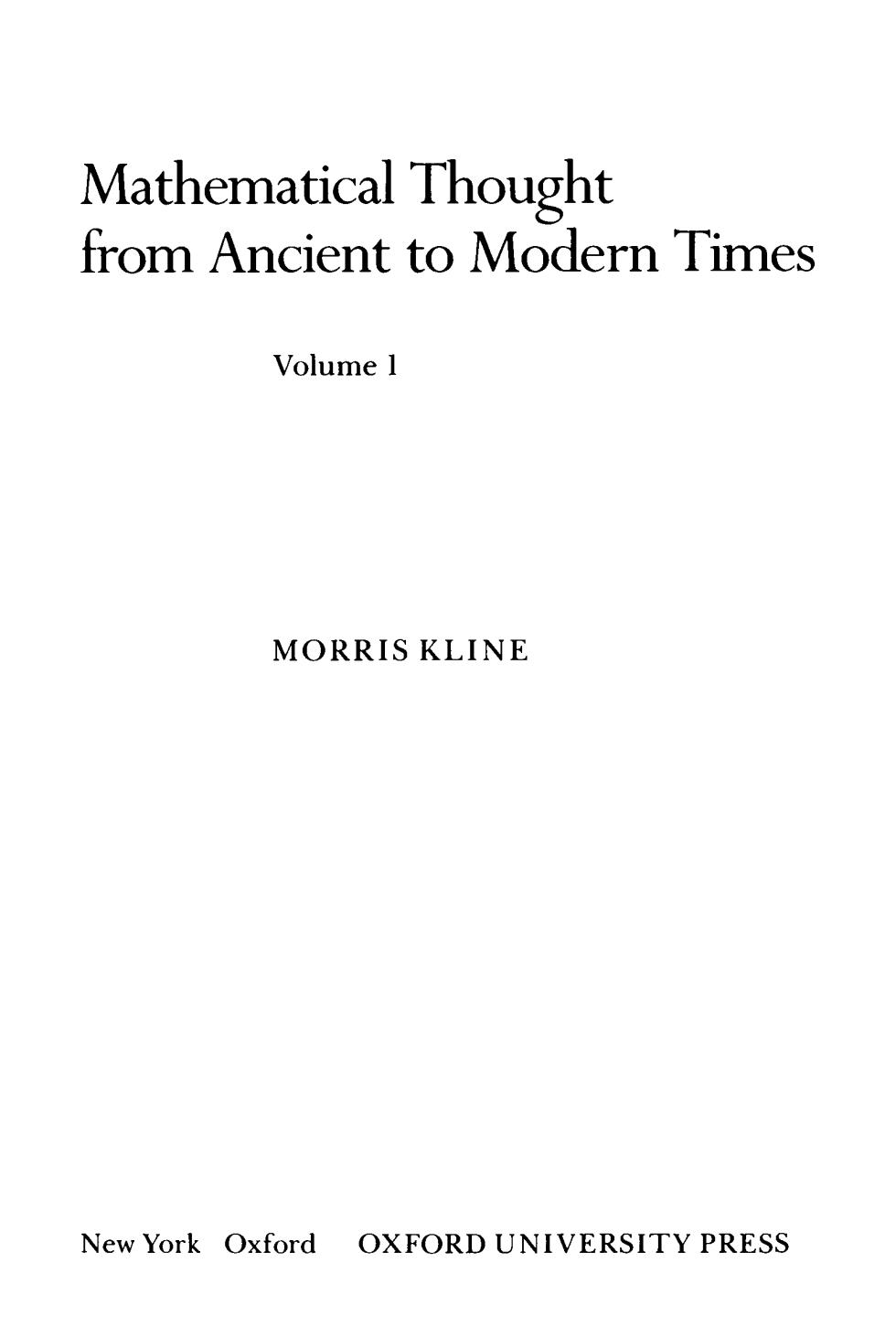
Mathematical Thought from Ancient to Modern Times Volume l MORRIS KLINE New York Oxford OXFORD UNIVERSITY PRESS
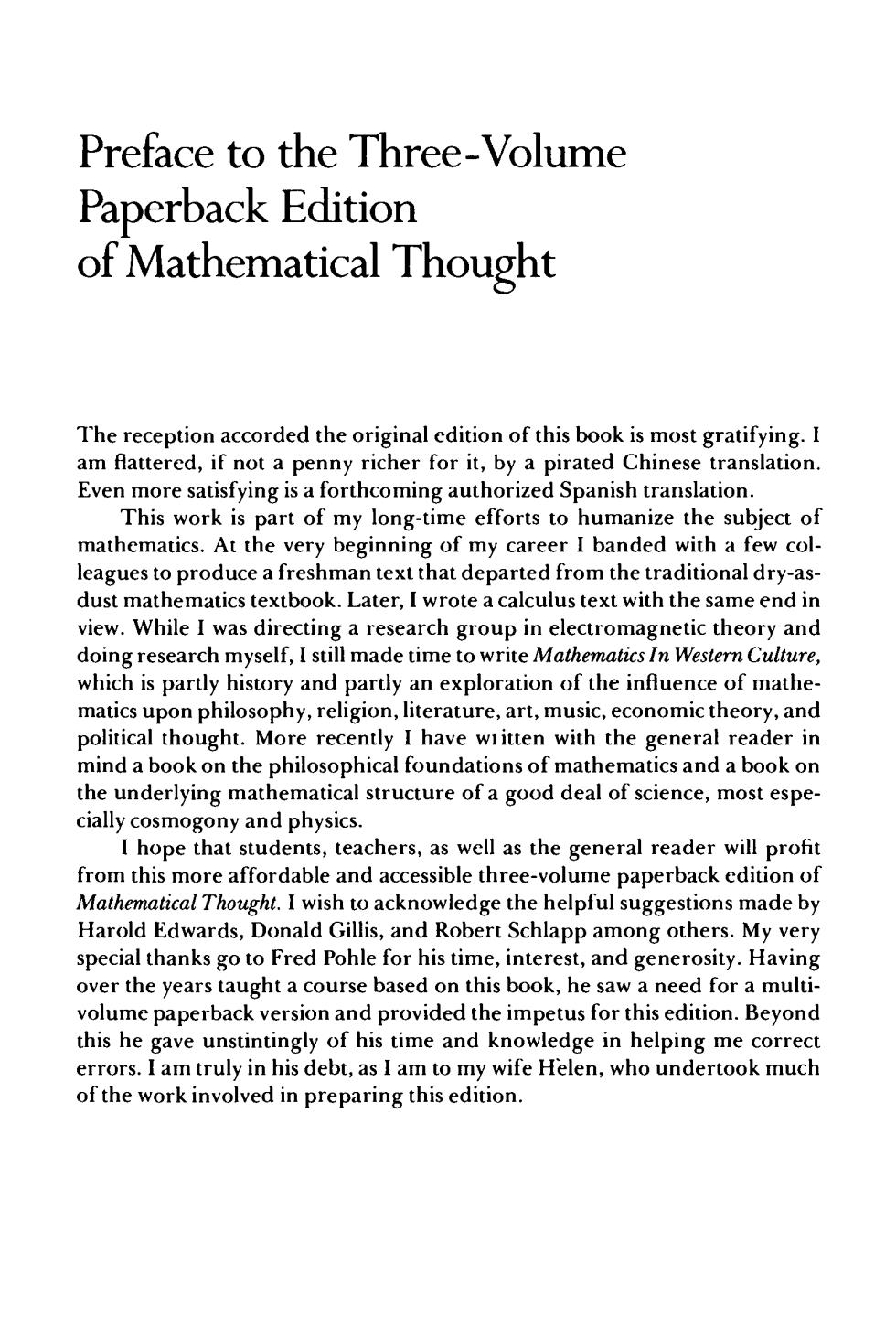
Preface to the Three-Volume Paperback Edition of Mathematical Thought The reception accorded the original edition of this book is most gratifying.I am flattered,if not a penny richer for it,by a pirated Chinese translation. Even more satisfying is a forthcoming authorized Spanish translation. This work is part of my long-time efforts to humanize the subject of mathematics.At the very beginning of my career I banded with a few col- leagues to produce a freshman text that departed from the traditional dry-as- dust mathematics textbook.Later,I wrote a calculus text with the same end in view.While I was directing a research group in electromagnetic theory and doing research myself,I still made time to write Mathematics In Western Culture, which is partly history and partly an exploration of the influence of mathe- matics upon philosophy,religion,literature,art,music,economic theory,and political thought.More recently I have wiitten with the general reader in mind a book on the philosophical foundations of mathematics and a book on the underlying mathematical structure of a good deal of science,most espe- cially cosmogony and physics. I hope that students,teachers,as well as the general reader will profit from this more affordable and accessible three-volume paperback edition of Mathematical Thought.I wish to acknowledge the helpful suggestions made by Harold Edwards,Donald Gillis,and Robert Schlapp among others.My very special thanks go to Fred Pohle for his time,interest,and generosity.Having over the years taught a course based on this book,he saw a need for a multi- volume paperback version and provided the impetus for this edition.Beyond this he gave unstintingly of his time and knowledge in helping me correct errors.I am truly in his debt,as I am to my wife Helen,who undertook much of the work involved in preparing this edition
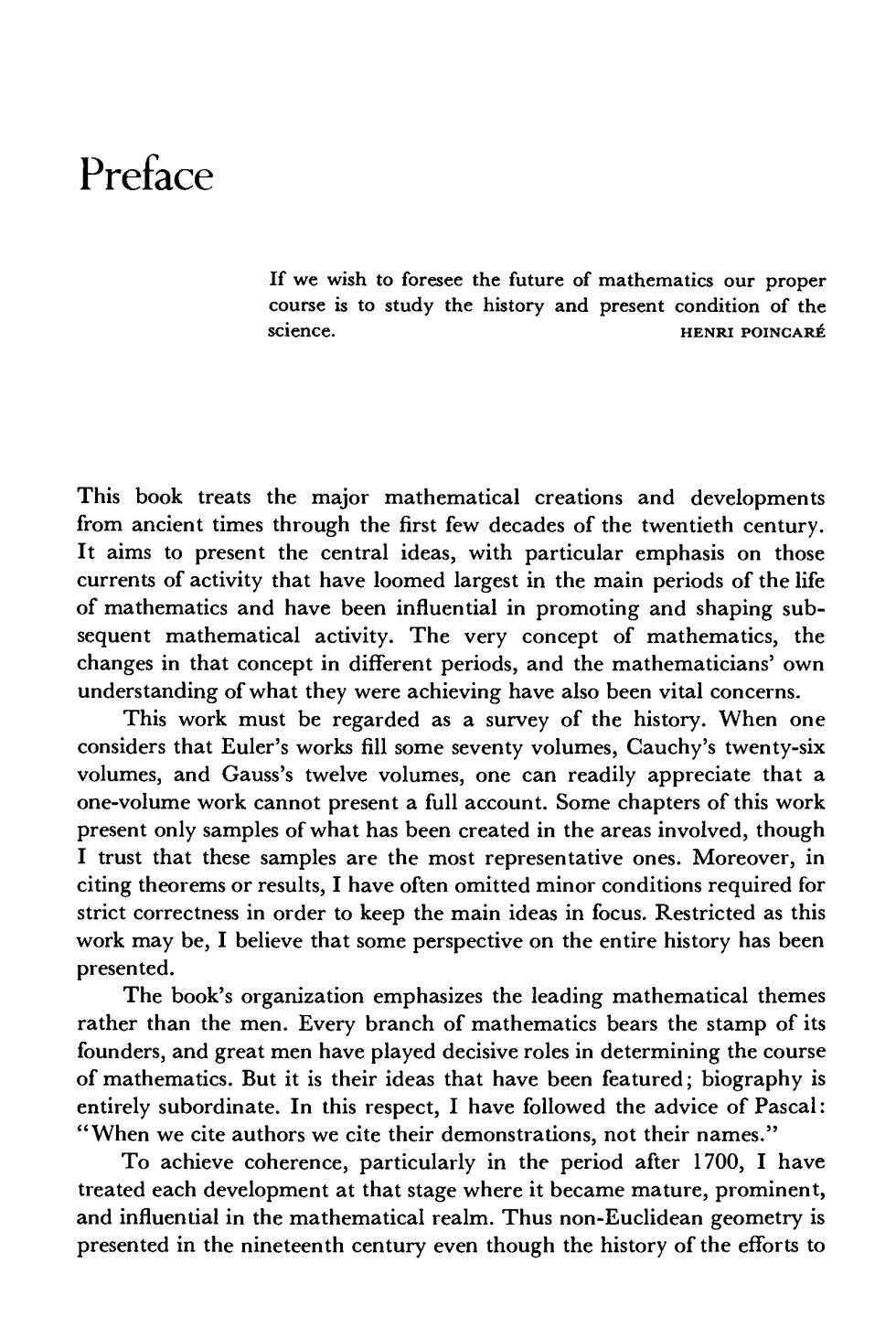
Preface If we wish to foresee the future of mathematics our proper course is to study the history and present condition of the science. HENRI POINCARE This book treats the major mathematical creations and developments from ancient times through the first few decades of the twentieth century. It aims to present the central ideas,with particular emphasis on those currents of activity that have loomed largest in the main periods of the life of mathematics and have been influential in promoting and shaping sub sequent mathematical activity.The very concept of mathematics,the changes in that concept in different periods,and the mathematicians'own understanding of what they were achieving have also been vital concerns. This work must be regarded as a survey of the history.When one considers that Euler's works fill some seventy volumes,Cauchy's twenty-six volumes,and Gauss's twelve volumes,one can readily appreciate that a one-volume work cannot present a full account.Some chapters of this work present only samples of what has been created in the areas involved,though I trust that these samples are the most representative ones.Moreover,in citing theorems or results,I have often omitted minor conditions required for strict correctness in order to keep the main ideas in focus.Restricted as this work may be,I believe that some perspective on the entire history has been presented. The book's organization emphasizes the leading mathematical themes rather than the men.Every branch of mathematics bears the stamp of its founders,and great men have played decisive roles in determining the course of mathematics.But it is their ideas that have been featured;biography is entirely subordinate.In this respect,I have followed the advice of Pascal: 'When we cite authors we cite their demonstrations,not their names." To achieve coherence,particularly in the period after 1700,I have treated each development at that stage where it became mature,prominent, and influential in the mathematical realm.Thus non-Euclidean geometry is presented in the nineteenth century even though the history of the efforts to

PREFACE replace or prove the Euclidean parallel axiom date from Euclid's time onward.Of course,many topics recur at various periods. To keep the material within bounds I have ignored several civilizations such as the Chinese,Japanese,and Mayan because their work had no material impact on the main line of mathematical thought.Also some developments in mathematics,such as the theory of probability and the calculus of finite differences,which are important today,did not play major roles during the period covered and have accordingly received very little attention.The vast expansion of the last few decades has obliged me to include only those creations of the twentieth century that became significant in that period.To continue into the twentieth century the extensions of such subjects as ordinary differential equations or the calculus of variations would call for highly specialized material of interest only to research men in those fields and would have added inordinately to the size of the work.Beyond these considerations,the importance of many of the more recent developments cannot be evaluated objectively at this time.The history of mathematics teaches us that many subjects which aroused tremendous enthusiasm and engaged the attention of the best mathematicians ultimately faded into oblivion.One has but to recall Cayley's dictum that projective geometry is all geometry,and Sylvester's assertion that the theory of algebraic invariants summed up all that is valuable in mathematics.Indeed one of the interesting questions that the history answers is what survives in mathematics.History makes its own and sounder evaluations. Readers of even a basic account of the dozens of major developments cannot be expected to know the substance of all these developments.Hence except for some very elementary areas the contents of the subjects whose his- tory is being treated are also described,thus fusing exposition with history. These explanations of the various creations may not clarify them completely but should give some idea of their nature.Consequently this book may serve to some extent as a historical introduction to mathematics.This approach is certainly one of the best ways to acquire understanding and appreciation. I hope that this work will be helpful to professional and prospective mathematicians.The professional man is obliged today to devote so much of his time and energy to his specialty that he has little opportunity to familiar- ize himself with the history of his subject.Yet this background is important. The roots of the present lie deep in the past and almost nothing in that past is irrelevant to the man who seeks to understand how the present came to be what it is.Moreover,mathematics,despite the proliferation into hundreds branches.is a unity and has its maior problems and goals.Unless the various specialties contribute to the heart of mathematics they are likely to be thematics is ava
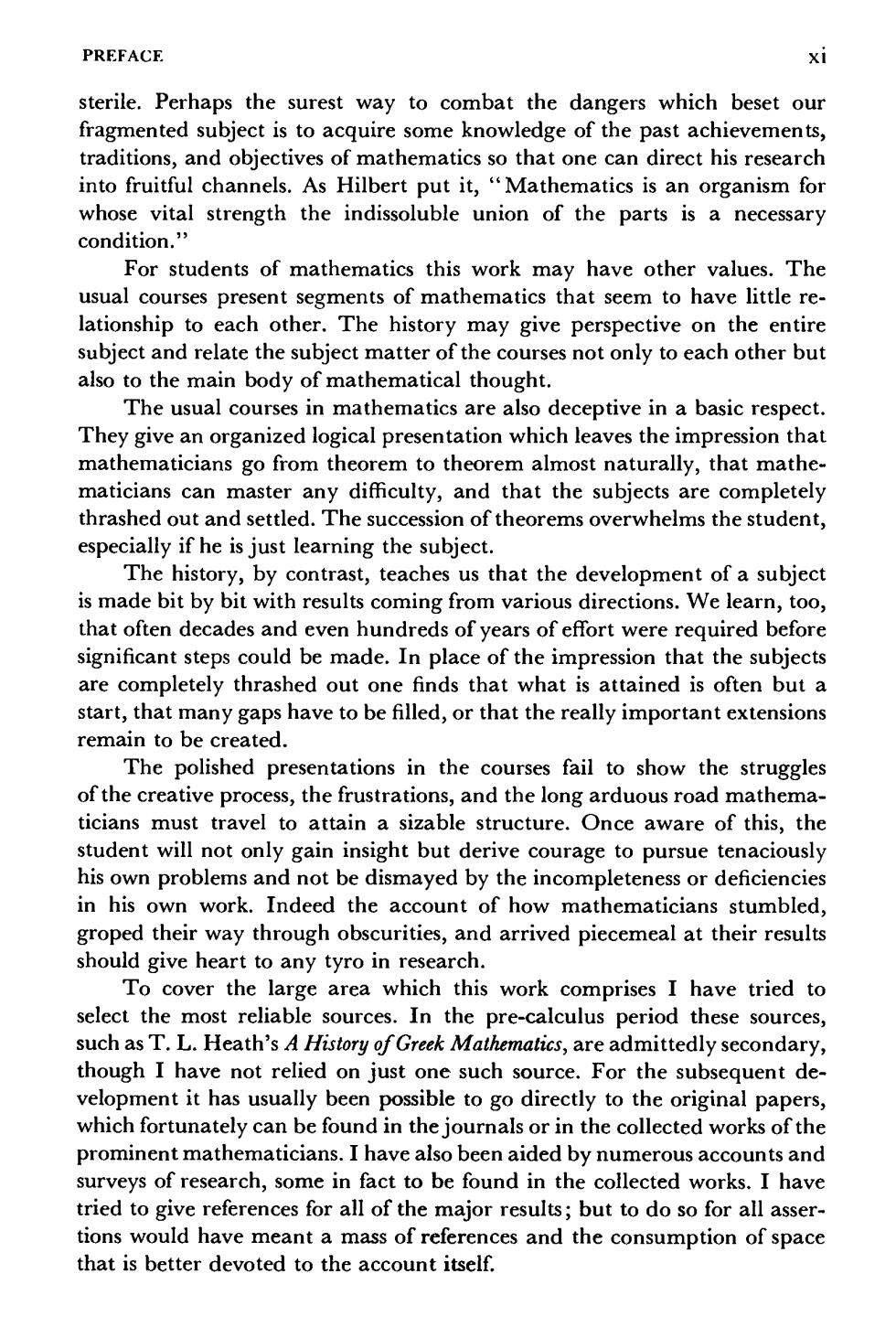
PREFACE xi sterile.Perhaps the surest way to combat the dangers which beset our fragmented subject is to acquire some knowledge of the past achievements. traditions,and objectives of mathematics so that one can direct his research into fruitful channels.As Hilbert put it,"Mathematics is an organism for whose vital strength the indissoluble union of the parts is a necessary condition.” For students of mathematics this work may have other values.The usual courses present segments of mathematics that seem to have little re- lationship to each other.The history may give perspective on the entire subject and relate the subject matter of the courses not only to each other but also to the main body of mathematical thought. The usual courses in mathematics are also deceptive in a basic respect. They give an organized logical presentation which leaves the impression that mathematicians go from theorem to theorem almost naturally,that mathe- maticians can master any difficulty,and that the subjects are completely thrashed out and settled.The succession of theorems overwhelms the student, especially if he is just learning the subject. The history,by contrast,teaches us that the development of a subject is made bit by bit with results coming from various directions.We learn,too, that often decades and even hundreds of years of effort were required before significant steps could be made.In place of the impression that the subjects are completely thrashed out one finds that what is attained is often but a start,that many gaps have to be filled,or that the really important extensions remain to be created. The polished presentations in the courses fail to show the struggles of the creative process,the frustrations,and the long arduous road mathema- ticians must travel to attain a sizable structure.Once aware of this,the student will not only gain insight but derive courage to pursue tenaciously his own problems and not be dismayed by the incompleteness or deficiencies in his own work.Indeed the account of how mathematicians stumbled, groped their way through obscurities,and arrived piecemeal at their results should give heart to any tyro in research. To cover the large area which this work comprises I have tried to select the most reliable sources.In the pre-calculus period these sources such as T.L.Heath's A History of Greek Mathematics,are admittedly secondary, though I have not relied on just one such source.For the subsequent de velopment it has usually been possible to go directly to the original papers, which fortunately can be found in the journals or in the collected works of the prominent mathematicians.I have also been aided by numerous accounts and surveys of research.some in fact to be found in the collected works.I have tried to give references for all of the major results;but to do so for all asser- tions would have meant a mass of references and the consumption of space that is better devoted to the account itself
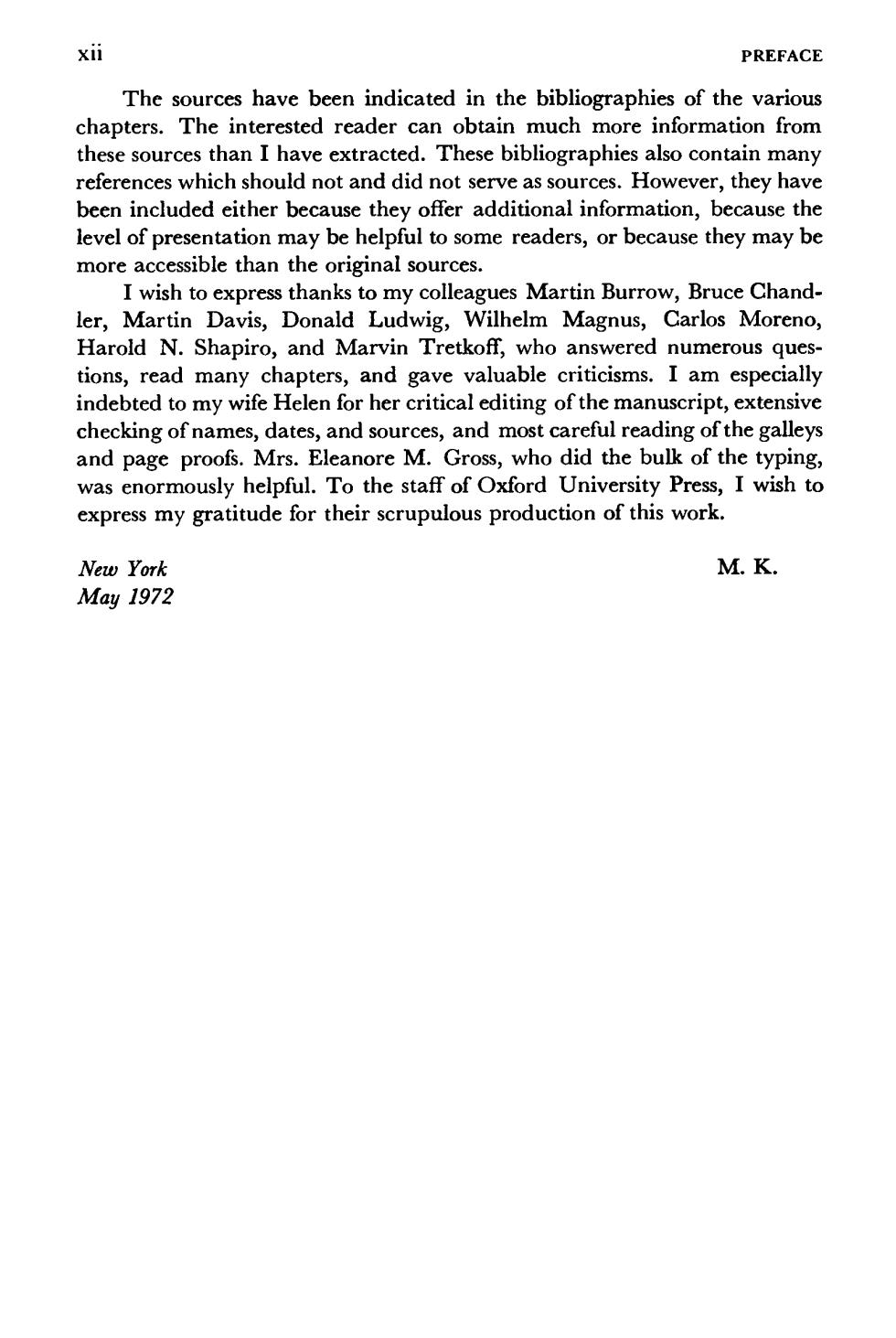
xii PREFACE The sources have been indicated in the bibliographies of the various chapters.The interested reader can obtain much more information from these sources than I have extracted.These bibliographies also contain many references which should not and did not serve as sources.However,they have been included either because they offer additional information,because the level of presentation may be helpful to some readers,or because they may be more accessible than the original sources. I wish to express thanks to my colleagues Martin Burrow,Bruce Chand ler,Martin Davis,Donald Ludwig,Wilhelm Magnus,Carlos Moreno, Harold N.Shapiro,and Marvin Tretkoff,who answered numerous ques tions,read many chapters,and gave valuable criticisms.I am especially indebted to my wife Helen for her critical editing of the manuscript,extensive checking of names,dates,and sources,and most careful reading of the galleys and page proofs.Mrs.Eleanore M.Gross,who did the bulk of the typing, was enormously helpful.To the staff of Oxford University Press,I wish to express my gratitude for their scrupulous production of this work. New York M.K. May 1972
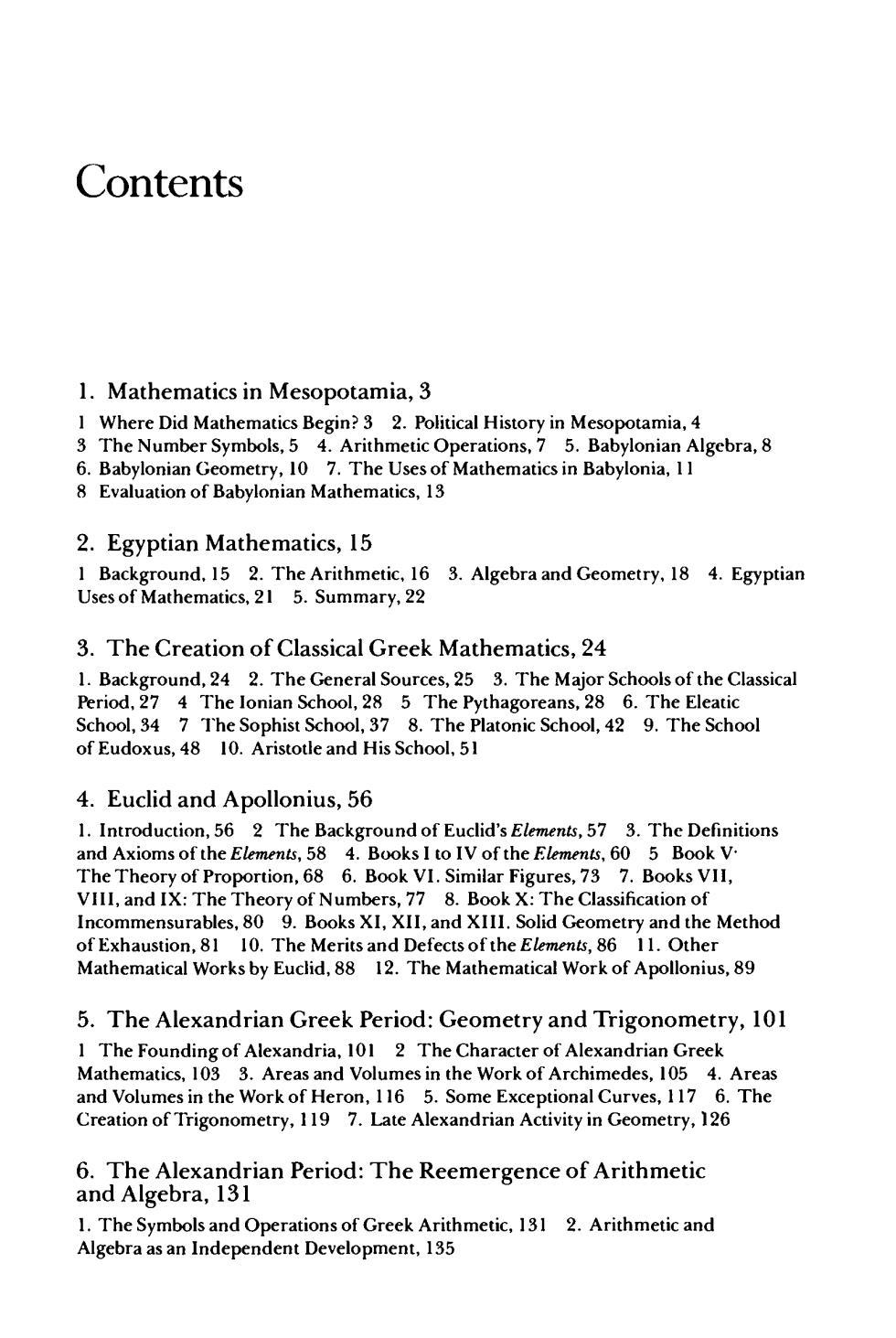
Contents 1.Mathematics in Mesopotamia,3 1 Where Did Mathematics Begin?3 2.Political History in Mesopotamia.4 3 The Number Symbols,5 4.Arithmetic Operations,7 5.Babylonian Algebra,8 6.Babylonian Geometry,10 7.The Uses of Mathematics in Babylonia,11 8 Evaluation of Babylonian Mathematics,13 2.Egyptian Mathematics,15 3.Algebra and Geometry,18 4.Egyptian ematics,2 3.The Creation of Classical Greek Mathematics,24 1.Background,24 2.The General Sources,25 3.The Major Schools of the Classical Period,27 4 The lonian School,28 5 The Pythagoreans,28 6.The Eleatic School,34 7 The Sophist School,37 8.The Platonic School,42 9.The School of Eudoxus,48 10.Aristotle and His School,51 4.Euclid and Apollonius,56 1.Introduction,56 2 The Background of Euclid's Elements,57 3.The Definitions and Axioms of the Elements,58 4.Books I to IV of the Elements,60 5 Book V. The Theory of Proportion,68 6.Book VI.Similar Figures,73 7.Books VII, VIIl,and IX:The Theory of Numbers.77 8.Book X:The Classification of nsurables.80 9.Books XI,XII,and XIII.Solid Geometry and the Method of Exhaustion.81 10.The Merits and Defects of the Elements.86 11.Other Mathematical Works by Euclid,88 12.The Mather matical Work of Apollonius,89 5.The Alexandrian Greek Period:Geometry and Trigonometry,101 1 The Foundingof Alexandria,Cha Mathe acter of Alexandrian Greck Area and Volumes in the Work of Archimedes,10 umes in the Work of Heron,116 5.Some Exceptional Curves,117 6.The and Volumes Creation of Trigonometry,119 7.Late Alexandrian Activity in Geometry,126 6.The Alexandrian Period:The Reemergence of Arithmetic and Algebra,131 1.The Symbols and Operations of Greek Arithmetic,131 2.Arithmetic and Algebra as an Independent Development,135
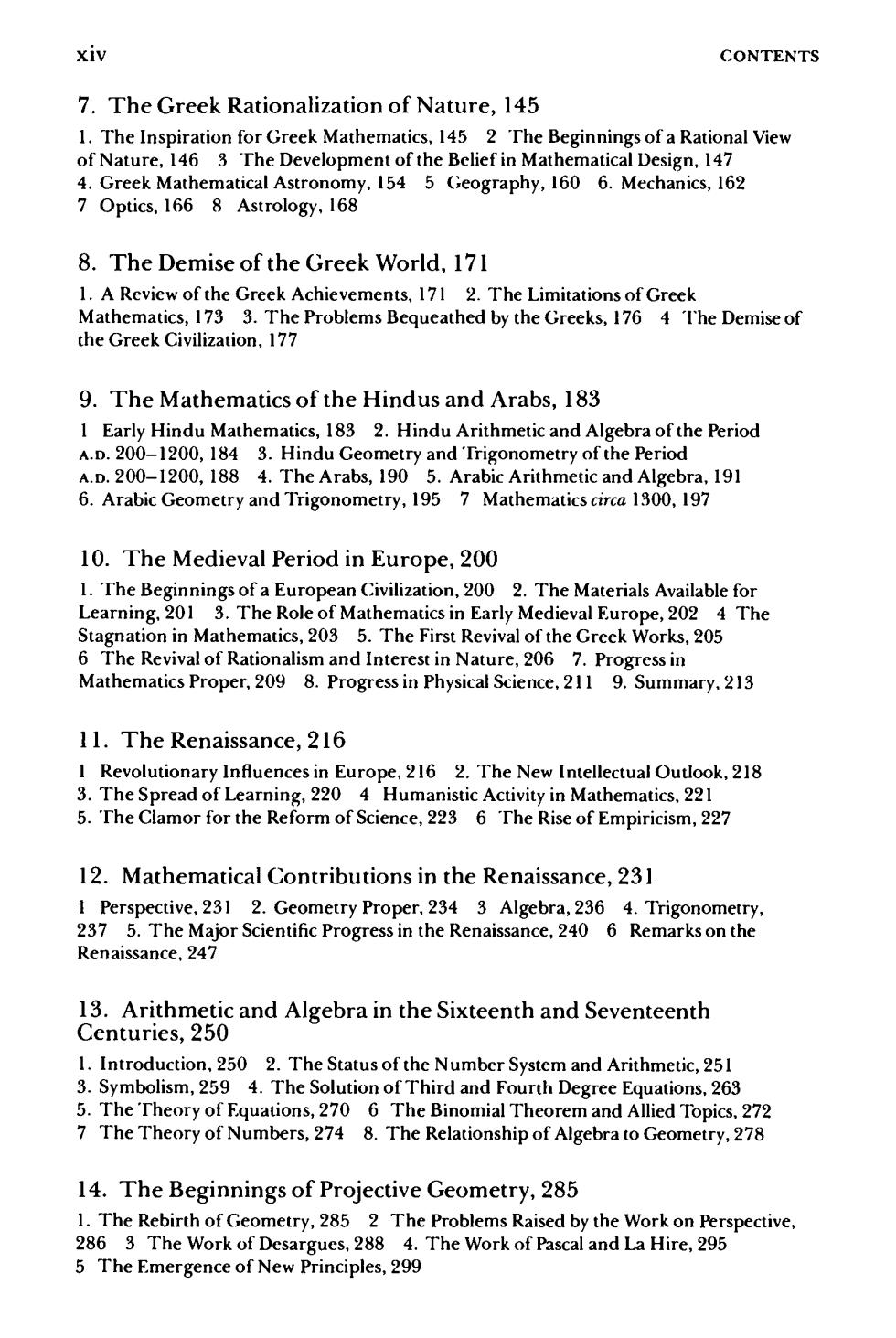
xiv CONTENTS 7.The Greek Rationalization of Nature,145 1.The Inspiration for Greek Mathematics.145 2 The Beginnings of a Rational View of Nature,146 3 The Development of the Belief in Mathematical Design.147 4.Greek Mathematical Astronomy,154 5 Geography,160 6.Mechanics,162 7 Optics,166 8 Astrology.168 8.The Demise of the Greek World,171 1.A Review of the Greek Achievements,171 2.The Limitationsof Greek Mathematics,173 3.The Problems Bequeathed by the Greeks,176 4 The Demise of the Greek Civilization,177 9.The Mathematics of the Hindus and Arabs,183 1 Early Hindu Mathematics,183 2.Hindu Arithmetic and Algebra of the Period A.D.200-1200,184 3.Hindu Geometry and 'Trigonometry of the Period A.D.200-1200,188 4.The Arabs,190 5.Arabic Arithmetic and Algebra,191 6.Arabic Geometry and Trigonometry.195 7 Mathematics circa 1300.197 10.The Medieval Period in Europe,200 1.The Beginnings of a European Civilization,200 2.The Materials Available for Learning.201 3.The Role of Mathematics in Early Medieval Europe,202 4 The Stagnation in Mathematics,203 5.The First Revival of the Greek Works,205 6 The Revival of Rationalism and Interest in Nature,206 7.Progress in Mathematics Proper,209 8.Progress in Physical Science,211 9.Summary,213 11.The Renaissance,216 1 Revolutionary Influences in Europe,216 2.The New Intellectual Outlook,218 3.The Spread of Learning,220 4 Humanistic Activity in Mathematics,221 5.The Clamor for the Reform of Science,223 6 The Rise of Empiricism,227 12.Mathematical Contributions in the Renaissance,231 I Perspective,231 2.Geometry Proper,234 3 Algebra,236 4.Trigonometry, 237 5.The Major Scientific Progress in the Renaissance,240 6 Remarks on the Renaissance.247 13.Arithmetic and Algebra in the Sixteenth and Seventeenth Centuries,250 1.Introduction,250 2.The Status of the Number System and Arithmetic,251 Symbolism,259 4.The Solution of Third and Fourth Degree Equations.263 5.The 'Theory of Equations,270 6 The Binomial Theorem and Allied Topics,272 7 The Theory of Numbers,274 8.The Relationship of Algebra to Geometry,278 14.The Beginnings of Projective Geometry,285 netry,285 hekene work of Desg principles. 288 The Emergence of New
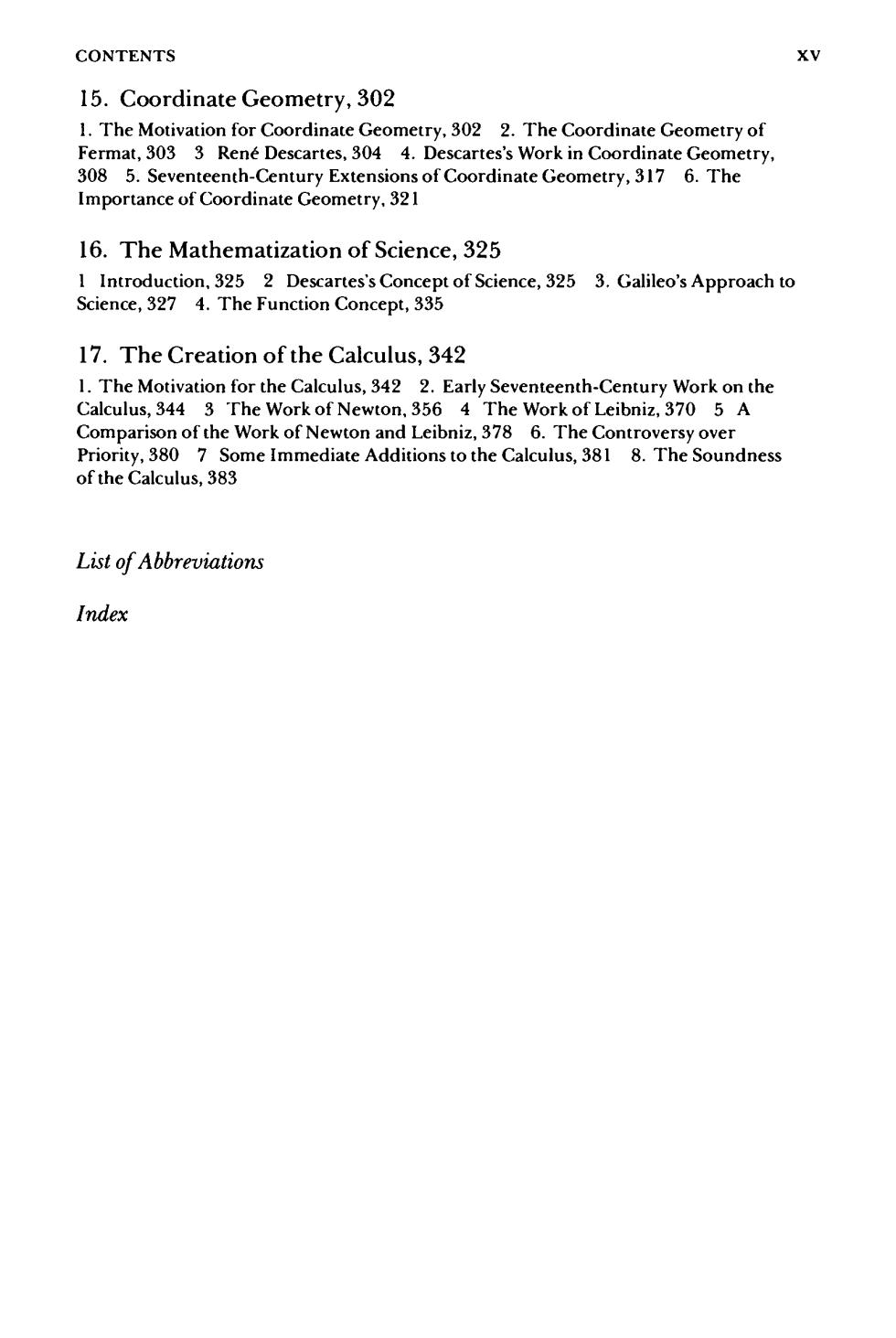
CONTENTS XV 15.Coordinate Geometry,302 1.The Motivation for Coordinate Geometry.302 2.The Coordinate Geometry of at,303 3 Rene Descartes.304 4.Desc tes's Work in C mporianeGrohc 308 5.Sevente rdinat cometry,321 16.The Mathematization of Science,325 1 Introduction.325 2 Descartes's Concept of Science,325 3.Galileo's Approach to Science,327 4.The Function Concept,335 17.The Creation of the Calculus,342 1.The Motivation for the Calculus,342 2.Early Seventeenth-Century Work on the Calculus,344 3 The Work of Newton,356 4 The Work of Leibniz,370 5 A Comparison of the Work of Newton and Leibniz,378 6.The Controversy over Priority,380 7 Some Immediate Additions to the Calculus,381 8.The Soundness of the Calculus,383 List of Abbreviations Index
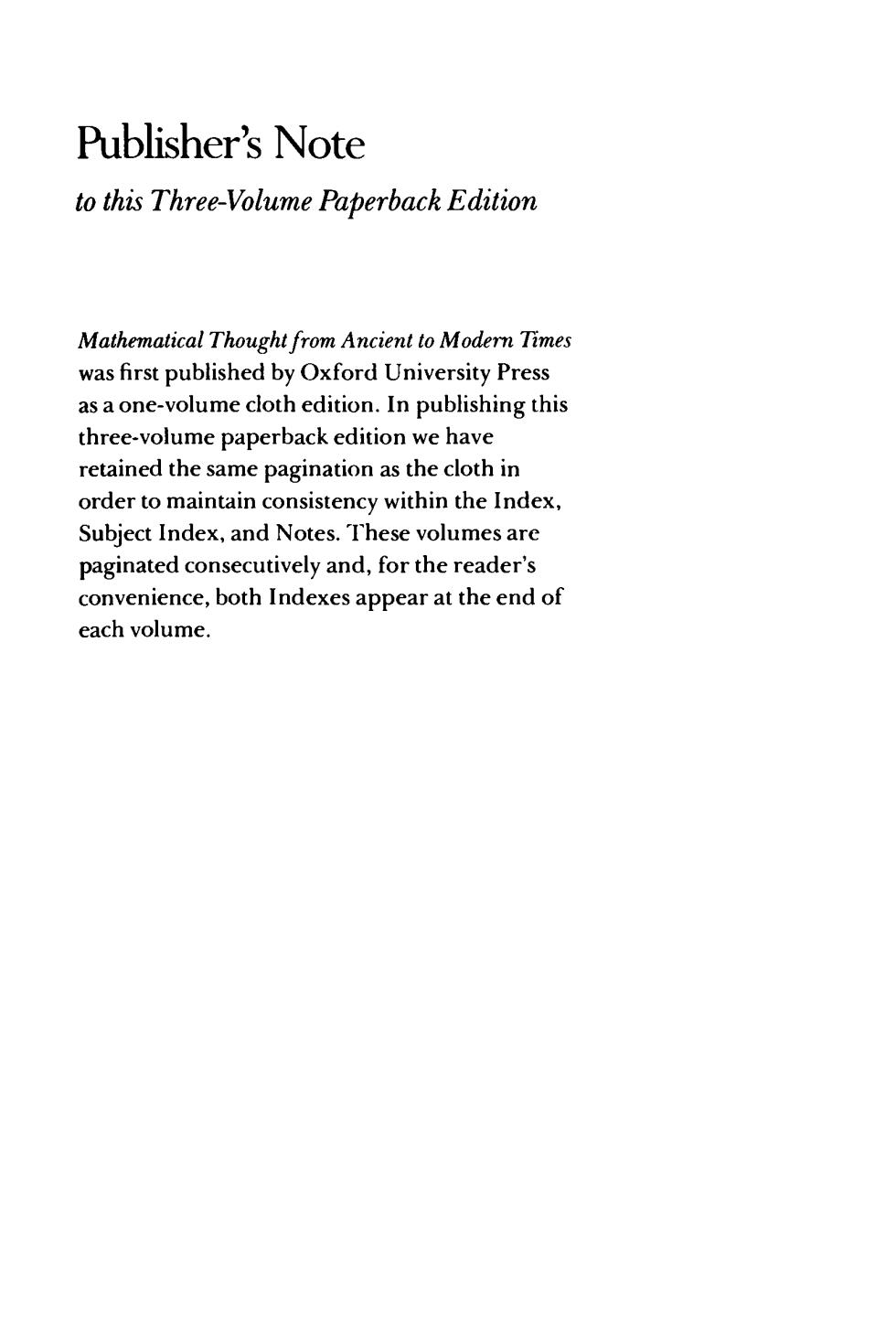
Publisher's Note to this Three-Volume Paperback Edition Mathematical Thought from Ancient to Modern Times was first published by Oxford University Press as a one-volume cloth edition.In publishing this three-volume paperback edition we have retained the same pagination as the cloth in order to maintain consistency within the Index, Subject Index,and Notes.These volumes are paginated consecutively and,for the reader's convenience,both Indexes appear at the end of each volume